Guangzhou–Shenzhen–Hong Kong Express Rail Link Hong Kong section
|
Route of Guangzhou-Shenzhen-Hong Kong XRL Hong Kong Section | |||||||||||||||||||||||||||||||||||||||||||||||||||||||||||||||||||||||||||||||||||||||||||||||||||||||||||||||||||||||||||||||||||||||||||||||||||||||||||||||||||||||||||||||||||||||||||||||||||||||||||||||||||||||||
| Overview | |||||||||||||||||||||||||||||||||||||||||||||||||||||||||||||||||||||||||||||||||||||||||||||||||||||||||||||||||||||||||||||||||||||||||||||||||||||||||||||||||||||||||||||||||||||||||||||||||||||||||||||||||||||||||
|---|---|---|---|---|---|---|---|---|---|---|---|---|---|---|---|---|---|---|---|---|---|---|---|---|---|---|---|---|---|---|---|---|---|---|---|---|---|---|---|---|---|---|---|---|---|---|---|---|---|---|---|---|---|---|---|---|---|---|---|---|---|---|---|---|---|---|---|---|---|---|---|---|---|---|---|---|---|---|---|---|---|---|---|---|---|---|---|---|---|---|---|---|---|---|---|---|---|---|---|---|---|---|---|---|---|---|---|---|---|---|---|---|---|---|---|---|---|---|---|---|---|---|---|---|---|---|---|---|---|---|---|---|---|---|---|---|---|---|---|---|---|---|---|---|---|---|---|---|---|---|---|---|---|---|---|---|---|---|---|---|---|---|---|---|---|---|---|---|---|---|---|---|---|---|---|---|---|---|---|---|---|---|---|---|---|---|---|---|---|---|---|---|---|---|---|---|---|---|---|---|---|---|---|---|---|---|---|---|---|---|---|---|---|---|---|---|---|
| Locale | Kowloon and New Territories, Hong Kong | ||||||||||||||||||||||||||||||||||||||||||||||||||||||||||||||||||||||||||||||||||||||||||||||||||||||||||||||||||||||||||||||||||||||||||||||||||||||||||||||||||||||||||||||||||||||||||||||||||||||||||||||||||||||||
| Transit type | Passenger high-speed rail | ||||||||||||||||||||||||||||||||||||||||||||||||||||||||||||||||||||||||||||||||||||||||||||||||||||||||||||||||||||||||||||||||||||||||||||||||||||||||||||||||||||||||||||||||||||||||||||||||||||||||||||||||||||||||
| Number of stations | 1 | ||||||||||||||||||||||||||||||||||||||||||||||||||||||||||||||||||||||||||||||||||||||||||||||||||||||||||||||||||||||||||||||||||||||||||||||||||||||||||||||||||||||||||||||||||||||||||||||||||||||||||||||||||||||||
| Operation | |||||||||||||||||||||||||||||||||||||||||||||||||||||||||||||||||||||||||||||||||||||||||||||||||||||||||||||||||||||||||||||||||||||||||||||||||||||||||||||||||||||||||||||||||||||||||||||||||||||||||||||||||||||||||
| Operation will start | 2018 | ||||||||||||||||||||||||||||||||||||||||||||||||||||||||||||||||||||||||||||||||||||||||||||||||||||||||||||||||||||||||||||||||||||||||||||||||||||||||||||||||||||||||||||||||||||||||||||||||||||||||||||||||||||||||
| Technical | |||||||||||||||||||||||||||||||||||||||||||||||||||||||||||||||||||||||||||||||||||||||||||||||||||||||||||||||||||||||||||||||||||||||||||||||||||||||||||||||||||||||||||||||||||||||||||||||||||||||||||||||||||||||||
| System length | 26 km (16.16 mi) | ||||||||||||||||||||||||||||||||||||||||||||||||||||||||||||||||||||||||||||||||||||||||||||||||||||||||||||||||||||||||||||||||||||||||||||||||||||||||||||||||||||||||||||||||||||||||||||||||||||||||||||||||||||||||
| Track gauge | 1,435 mm (4 ft 8 1⁄2 in) | ||||||||||||||||||||||||||||||||||||||||||||||||||||||||||||||||||||||||||||||||||||||||||||||||||||||||||||||||||||||||||||||||||||||||||||||||||||||||||||||||||||||||||||||||||||||||||||||||||||||||||||||||||||||||
| Electrification | 50Hz 25,000V (AC) | ||||||||||||||||||||||||||||||||||||||||||||||||||||||||||||||||||||||||||||||||||||||||||||||||||||||||||||||||||||||||||||||||||||||||||||||||||||||||||||||||||||||||||||||||||||||||||||||||||||||||||||||||||||||||
| Top speed | 200 km/h (120 mph) | ||||||||||||||||||||||||||||||||||||||||||||||||||||||||||||||||||||||||||||||||||||||||||||||||||||||||||||||||||||||||||||||||||||||||||||||||||||||||||||||||||||||||||||||||||||||||||||||||||||||||||||||||||||||||
| |||||||||||||||||||||||||||||||||||||||||||||||||||||||||||||||||||||||||||||||||||||||||||||||||||||||||||||||||||||||||||||||||||||||||||||||||||||||||||||||||||||||||||||||||||||||||||||||||||||||||||||||||||||||||

The Guangzhou-Shenzhen-Hong Kong Express Rail Link Hong Kong Section (XRL HK Section) is a proposed high-speed railway connecting Kowloon with the high-speed rail network of China at Shenzhen. As its name suggests, it is part of the rail link between Hong Kong and Guangzhou, the capital of Guangdong Province.
Current plan
In April 2007, the Executive Council assigned the task of planning and design of the Hong Kong section of the Guangzhou–Shenzhen–Hong Kong Express Rail Link (XRL) to the MTR Corporation Limited (MTRCL). Government projections indicate that the XRL will carry about 100,000 passengers daily in 2020 and 120,000 passengers in 2030, generating an economic benefit of HK$83 billion over the next 50 years in terms of travelling time saved. Construction costs were estimated at HK$39.5 billion (US$5 billion), giving an economic internal rate of return of about 9%.[1] The government stated the objectives were to "reinforce Hong Kong's position as the transport hub in southern China and integrate Hong Kong into the country's rapidly growing express rail network", and promoting cultural tourism. It also argued that shortening the travelling time between Hong Kong and Guangzhou to just under 50 minutes—half the current journey time— would save "HK$83 billion over the next 50 years in terms of travelling time", and the creation of 5,000 jobs during construction, and 10,000 operational jobs.[1]
The XRL HK Section will only serve the West Kowloon Terminus. Trains will run to Guangzhou South Station in the Shibi Township of the Panyu District in southern Guangzhou through three intermediate stations, namely, Futian, Longhua (Shenzhen North) and Humen.[2][3] The expected travel time between Guangzhou South and West Kowloon stations is estimated to be 48 minutes, with a total distance of 142 kilometers.
Shenzhen North Station was open on 22 June 2011, and Futian Station is expected to open in 2014. Trains departed from Hong Kong may have destinations beyond Guangzhou, through the Wuguang High-Speed Railway and the Shiwu High-Speed Railway, or via Shenzhen North to Hangzhou and Shanghai through the Xiashen Railway, Huhangyong Railway, etc.
Under the current plan the total distance of the Hong Kong section is 26 kilometres, most of which through underground tunnels.[4] The dedicated track will enable a top speed of 200 km/h;[4] the expected travel time from Kowloon to Shenzhen's Futian Station is 12 minutes.
The construction cost in Hong Kong will be covered by the Hong Kong taxpayer[1][5] (whereas the construction cost in the Mainland section will be covered by the Guangdong Provincial Government and PRC's Ministry of Railways).
Hoping to be able to start construction of the Hong Kong section of the Express Rail Link (XRL) project before the end of 2009, the Executive Council approved the implementation on 20 October, paving the way for funding approval from the Finance Committee of the Legislative Council.[4]
Appropriations for the project secured approval of the Hong Kong Legislative Council on 16 January 2010.[6]
Service between Guangzhou South and Shenzhen North stations started on 26 December 2011.[7] The extension to Futian station, originally scheduled for 2012, has been delayed until on 30 December 2015 and the 3rd quarter of 2018 at the latest as planned for West Kowloon Terminus.
Opposition to the project
On 29 November 2009, a demonstration of more than 1,000 people protesting against the construction of the Express Rail link gained the attention of the local media when a group of 100 people engaged in a sit-in protest in front of the government headquarters in Central.[8] On 18 December 2009, when the funding application was debated in the Finance Committee of the Legislative Council, a demonstration of an estimated 1,000 to 2,000 people was staged around the Legislative Council Building. The debate did not end at the time when the meeting was scheduled to be ended, and the funding application was not yet voted on.[9] A major protest followed in January 2010.
See also
References
- 1 2 3 "Green light for local section of Express Rail Link". Hong Kong Government. Retrieved 22 July 2008.
- ↑ Guangzhou-Shenzhen-Hong Kong Express Rail Link
- ↑ HONG KONG SECTION OF GUANGZHOU-SHENZHEN-HONG KONG EXPRESS RAIL LINK PROJECT PROFILE
- 1 2 3 ExCo approves implementation of high-speed rail link, Hong Kong Government, 20 October 2009
- ↑ 廣深港高速鐵路香港段工程項目簡介 (PDF) (in Chinese). Environmental Protection Department and MTR Corporation. Retrieved 22 July 2008.
- ↑ Song, Shengxia (18 January 2010), Hongkongers protest vote on high-speed rail, People's Daily, Global Times, retrieved 28 January 2010
- ↑ http://www.asiaone.com/News/AsiaOne+News/Asia/Story/A1Story20111226-318220.html
- ↑ Angry rail-link protesters clash with police, The Standard, 30 November 2009
- ↑ Opponents of high-speed rail link claim victory as pan-democrats delay funding, South China Morning Post, 19 December 2009
External links
- Express Rail Link(Hong Kong), MTR official site
- XRL Project, MTR official site
- expressrailtruth.com, Opposition site (Chinese)
Coordinates: 22°17′59″N 114°10′07″E / 22.2997°N 114.1686°E
